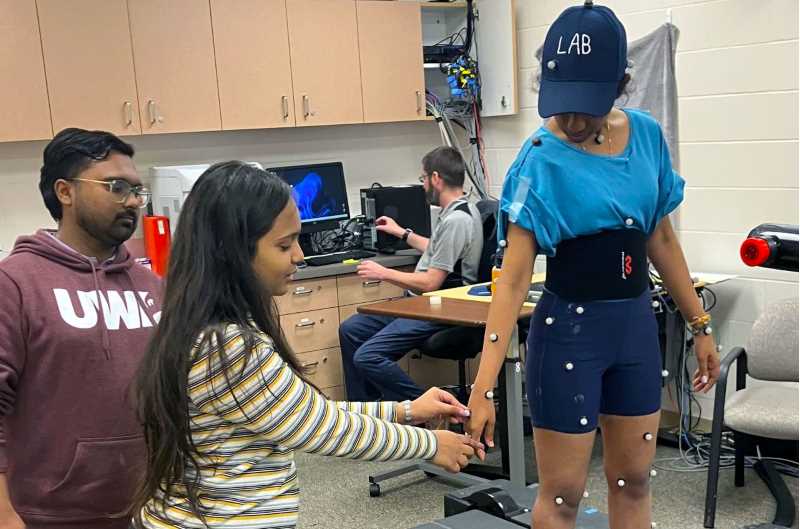Physical Therapy
Biomechanics lab equipment
3-D Video Based Motion Analysis System (Motion Analysis Corporation)
The Motion Analysis System is used to determine three dimensional kinematic information relative to movement performance. Information obtained in a kinematic assessment include position, velocity and acceleration of a segment or joint. Reflective surface markers are typically placed on segments that are tracked by computer frame by frame throughout the movement performance. One of our labs has 15 synchronized video cameras that track these markers at rates between 60-250 samples per second. From these data, one can provide a quantitative assessment of the movement pattern. In our second lab (the PACER lab), we have an 10 camera motion analysis system that is used with our instrumented treadmill. Data from these cameras are synchronized with force data from the treadmill that has force plates embedded under their belts. Together motion and force data can be captured during a more prolonged walk or run on this treadmill where multiple steps are acquired.
Learn more about 3-D Camera Based Motion Analysis System
Force Platforms (Bertec)
A force platform is used to measure the ground reaction forces during various activities. Forces are measured in the vertical, anterior posterior and medial lateral directions. Data are often combined with motion analysis measures using link segment modeling to calculate joint moments and joint reaction forces.
Pressure Distribution Measurements (Novel USA, Novel GMBH)
Pressure Distribution measurements are used to monitor the local loading on the tissue. Currently, our lab has three systems to measure pressure distribution: the Novel EMED Platform System for barefoot measurements, the Novel Pedar In-shoe System for measurements within footwear, and the Novel Pliance Seating System for seated measurements. All systems use capacitive sensor technology.
- Learn more about barefoot measurements
- Learn more about in-shoe measurements
- Learn more about seated measurements
Loadsols (Novel USA, Novel GMBH)
Loadsols are capacitive sensing insoles that can be used either within the lab or outside the lab environment. Force data are measured at 200 Hz using an Apple or Android device.
Instrumented Treadmill (Treadmetrix)
The PACER lab has a split-belt instrumented treadmill. This treadmill has two force plates below the belt to enable impact forces to be measured during sustained walking and or running. We also have a 10 camera motion capture system that allows us to measure motion of the performer on the treadmill.
Visual 3D (c-motion)
Visual 3D is a software package that is used to calculate biomechanical data from force platforms and motion capture data. Kinematic and kinetic data are used to model the body as rigid links to measure joint positions and joint kinetics of the performer.
Motion Monitor (Innovative Sports Training)
The Motion Monitor is a three dimensional, magnetic-based, kinematic sensing system which allows movement of body segments to be captured in real time at capture rates up to 140 samples per second. Information obtained in a kinematic assessment include position, velocity and acceleration of a body segment or joint. Sensors are placed on body segments that are tracked instantaneously during the movement performance. From these data, one can provide a quantitative assessment of the movement pattern. We also use Motion Monitor software calculating biomechanical data from our motion analysis system as well as providing feedback on performance from motion capture or force data.
Learn more about Motion Monitor
Computerized Posturography System (Bertec CDP)
A posturography system quantifies a persons postural control (balance) during upright standing in either static or dynamic conditions. The system manipulates various visual and somatosensory conditions to assess or train a participants postural control.
Electromyography (EMG) Systems (Delsys)
Electromyography (EMG) records the electrical activity of a muscle by placing electrodes on or in some cases within skeletal muscle (depending on the type of electrodes used). The EMG system consists of an amplifier that is interfaced with a computer. An amplifier is used to make the electrical signals larger since the electrical activity associated with muscle activity is so small. Several muscles can be monitored simultaneously during the movement performance to see the relative amount and sequence of muscle activity.
Electrogoniometers
These are used to measure joint position. These are often used in conjunction with EMG recordings.
Photoelectric Timing System
These are used to measure walking speed. Photocells are interfaced with a digital clock. When a subject crosses in front of one photocell the clock is started and the second photocell stops the clock as the subject passes. To convert this timing measure to speed we measure the distance between the photocells and divide the distance traveled by the elapsed time. These are often used in conjunction with pressure, force and kinematic measures so that speed can be monitored.
Accelerometer
Isokinetic Dynamometer (CSMI) and Handheld Dynamometers (various types)
Isokinetic measurements are measurements of muscular torque at a constant velocity. The computerized isokinetic dynamometer monitors and alters the resistance so that the movement velocity is held constant. Movement velocities can be determined at various velocities (up to 300 degrees/s). Typically, a joint is measured and the maximum torque output is calculated for that movement. This equipment is located in a therapeutic exercise room in the Health Science Center. We also use a variety of handheld dynamometers to objectively measure strength.
Learn more about CSMI Norm Isokinetic Dynamometer and Handheld Dynamometers
Ultrasound Imaging (GE)
Records ultrasound images for musculoskeletal, cardiovascular or internal organs.
Microscribe 3D digitizer
Records 3D location of shape landmarks for studies of morphometrics.
Anatomic Specimen Storage
Freezer and refrigerator for cold storage, various bins and containers for wet specimen preservation.
Dissection Equipment
Scalpels, probes, scissors, hemostats, saws and chisels for anatomical study.




![UWL College of Business Administration faculty and Mayo Clinic Health System leaders merged academic insight with industry expertise to help shape a better healthcare experience for all. [Pictured left to right: Uzay Damali and Tanner Holst, '01]](/contentassets/d2492d337f8a4841b98d59100cb0f8ab/2025-uwl-cba-mayo-article-collaboration-92.jpg/Medium)



